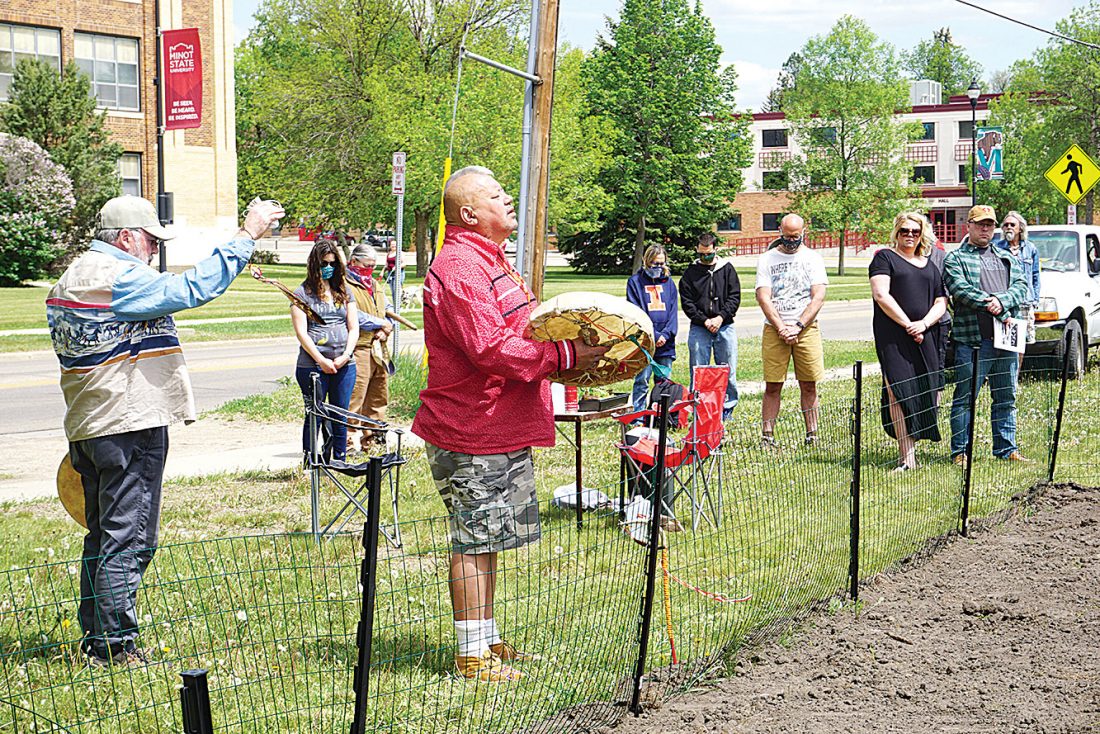Volunteers plant educational garden featuring Native traditions
Educational garden features Native plant traditions

Jill Schramm/MDN Madison Aiman, left, and Jana Schultz plant watermelon seeds Friday in a section of a community garden sponsored by dreamBIG Green Schools’ Red and Green School next to the Minot State University campus.
Volunteers were planting seeds following a traditional drum and prayer ceremony at a new community garden next to Minot State University Friday.
An educational, community garden focusing on native plants is the project of the nonprofit, dreamBIG Green Schools’ Red and Green School, which was awarded a $5,000 grant from the Bush Foundation through its Change Network Program to plant a neighborhood garden using indigenous planting traditions.
Knife River Indian Villages National Historic Site near Stanton donated the seeds and plants. A sampling of the crops include watermelon from the Arikara, beans, corn and Jerusalem artichoke from the Hidatsa and squash from the Arikara and Mandan. The garden also is growing ceremonial tobacco.
MSU associate professor Daniel Conn said the seed varieties have been preserved for generations and promise a crop that will thrive in North Dakota conditions.
“They are supposed to grow amazingly. They say you don’t need compost, but I still have it. It would seem wrong not to have it. Apparently, they are hardy,” Conn said.

Jill Schramm/MDN Duane McGillis sings and drums during a ceremony to celebrate planting of a community garden in northwest Minot Friday. At left, Warren Anderson holds ceremonial tobacco, part of the Native American blessing tradition.
The community garden will employ traditional techniques from the Three Affiliated Tribes at MHA Nation but also practices of other Native people, including the Ojibwe, Lakota, Dakota and Turtle Mountain Chippewa.
The project has support of Environmentally Minded People of Minot and campus groups that include the MSU Native American Center, Biology Club, Sustainability Committee, Teacher Education and First Year Experience.
The garden is located along University Avenue, across from Model Hall, on the middle of three now vacant lots purchased by the MSU Development Foundation after the flood.
Duane McGillis and Warren Anderson sang and drummed during the traditional prayer ceremony before volunteers began the planting Friday afternoon.
Annette Mennem, director of the Native American Center on campus, explained the sage and tobacco incense used during the ceremony are traditional for blessing and prayer. The Crow, Hidatsa and Ojibwe tribes all had a presence at one time in the area, she said.
Conn said volunteers will be maintaining the garden over the summer. In the fall, MSU students are likely to get involved.
“It is a good way to involve students in learning opportunities,” Conn said. “We think of this space as a school – a school without walls.”
The public and especially child-care providers and other children’s groups are invited to stop by and tour the garden. Visit redandgreenschool.org for more information about the garden and details on scheduling if interested in having an educational presentation for children.
“The whole focus of this has been education,” Conn said. “We very much want to involve young people in lots of different ways.”
Signs are to be erected to explain the crop traditions. Garden sponsors have been working with the North Dakota Historical Society, which had a representative on hand Friday.
The harvest could go for different uses, including donations to food pantries, Conn said.
- Jill Schramm/MDN Madison Aiman, left, and Jana Schultz plant watermelon seeds Friday in a section of a community garden sponsored by dreamBIG Green Schools’ Red and Green School next to the Minot State University campus.
- Jill Schramm/MDN Duane McGillis sings and drums during a ceremony to celebrate planting of a community garden in northwest Minot Friday. At left, Warren Anderson holds ceremonial tobacco, part of the Native American blessing tradition.




